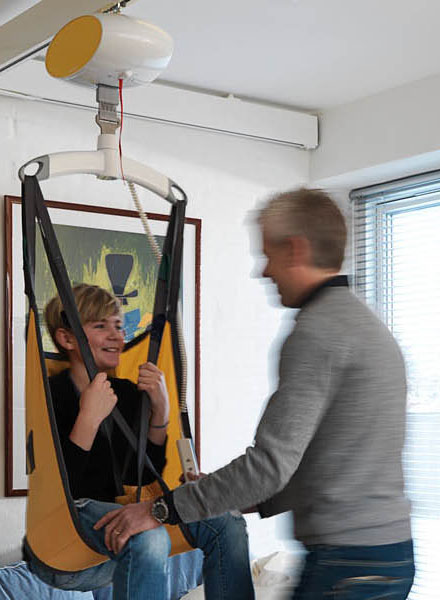By their very nature, ceiling lifts require no floor space and won’t ever get underfoot. The dexterity is unmatched, as ceiling tracks can easily reach any room and pass over a variety of fixtures like hot tubs (yup, plan the deck reno!), toilets, beds and showers. Ease of transfer is a breeze for both the user and the caregiver, especially in comparison to cumbersome older-style floor models. When it comes to home mobility, the ceiling lift offers stunning efficiency and makes transfer easier, safer and infinitely more fun. Travel along your track solo or with a caregiver. There are numerous sling design options to choose from, so zipping around your home will be smooth in this easy to operate and adaptabile tool.
Recommended Features

Questions about Ceiling Lifts?
The ceiling lift experts at Careage Home and Health are on call to answer your questions questions you have about Ceiling Lifts, or looking to order your own. We can help create you a customized plan of care that is right for you.
Why Use A Ceiling Lift?
Ceiling lifts are designed for seniors who are not able to transfer between furniture or mobility equipment. This can be due to weakness, pain, decreased coordination and or other health related issues. For the most part, it is better for the senior to be able to transfer on their own than to use a mechanical lift. That way they can maintain / improve their strength. However, this is not always possible and thus a ceiling lift is needed.
They are commonly set-up in the bedroom over the bed and used to transfer between bed, wheelchair and or their commode.
Also note that lifts are also commonly used to prevent injury to caregivers. Back and neck injuries can occur when transferring someone that needs moderate to maximum assistance without a lift.
Things to Consider Before Purchasing a Lift
Other Types of Lifts
More Resources
Do you require more information, or looking for operating manuals on some of the ceiling lift products we have? See below
| Attachment | Size |
|---|---|
| Download | |
